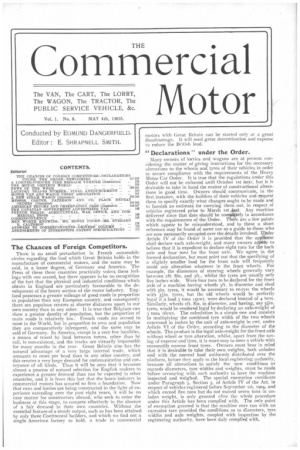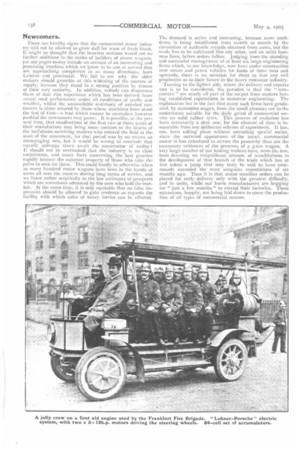The Chances of Foreign Competitors.
Page 1

Page 2

If you've noticed an error in this article please click here to report it so we can fix it.
There is no small perturbation in French automobile circles regarding the lead which Great Britain holds in the manufacture of commercial motors, and the same may be said, in a lesser degree, of Germany and America. The Press of these three countries practically voices these feelings with one accord, but there appears to be no recognition of the fact that the physical and industrial conditions which obtain in England are particularly favourable to the development of the heavy section of the motor industry. England possesses a greater mileage of good roads in proportion to population than any European country, and consequently there are populous centres at shorter distances apart in our own country than in any other. It is true that Belgium can show a greater density of population, but the proportion of main roads is relatively low. French roads are second to none in the World, but in proportion to area and population they are comparatively infrequent, and the same may be said of Germany. In America, except in a very few localities, a means of travel by land between towns, other than by rail, is non-existent, and the tracks are virtually impassable for many months in the year. Great Britain also has the natural advantage of a very large internal trade, which amounts to more per head than in any other country, and this creates a very large demand for communication and conveyance of all kinds. Thus it will be seen that it becomes almost a process of natural selection for English makers to experience a greater demand than can be expected in other countries, and it is from this fact that the home industry in commercial motors has secured so firm a foundation. Now that vans and lorries are being constructed in the light of experience extending over the past eight years, it will be no easy matter for constructors abroad, who seek to enter the business at this stage, to compete effectively in the absence of a fair demand in their own countries. Without the essential feature of a steady output, such as has been attained by only three Continental builders, and which we find not a single American factory to hold, a trade in commercial motors with Great Britain can be started only at a great disadvantage. It will need great determination and expense to reduce the British lead.
" Declarations " under the Order.
Many owners of lorries and wagons are at present considering the matter of giving instructions for the necessary alterations to the wheels and tyres of their vehicles in order to secure compliance with the requirements of the Heavy Motor Car Order. It is true that the regulations under this Order will not be enforced until October 1st itext, but it is desirable to take in hand the matter of constructional alterations in good time. Owners should communicate, in the first instance, with the builders of their vehicles and request them to specify exactly what changes ought to be made and to furnish an estimate for carrying them out, in respect of vehicles registered prior to March tst kat. Any machine delivered since that date should be completely in accordance with the requirements of the Order. There are a few points which appear to be misunderstood, and to these a short reference may be found of some use as a guide to those who are now necessarily occupied over the details involved. Under Article IV of the Order it is provided that the applicant shall declare each axle-weight, and many owners appear to believe that it is expedient to declare eight tons for the back axle and four tons for the front axle. We agree in the formed declaration, but must point out that the specifying of a slightly smaller load for the front axle will frequently avoid any alteration whatever in the front wheels. For example, the diameters of steering wheels generally vary between sft. 8in. and 3ft., whilst the tyres are usually only five inches wide. Were four tons to be declared for the front axle of a machine having wheels 3ft. in diameter and shod with sin. tyres, it would be necessary to re-tyre the wheels with gin. tyres, but the old wheels would be perfectly legal if a load 3 tons t5cwt. were declared instead of 4 tons. Similarly, wheels sft. 8in. in diameter, and having, say 5iin. tyres, would be rendered legal by declaring an axle-weight of 3 tons 16cwt. The calculation is a simple one and consists in multiplying the combined tyre width of the two wheels expressed in inches by the unit of axle-weight in cwt. under Article VI of the Order, according to the diameter of the wheels. The product is the legal axle-weight for the front axle without wheel or tyre alteration, whilst, apart from the saving of expense and time, it is more easy to steer a vehicle with reasonably narrow front tyres. Owners must bear in mind that it is desirable to take their own weights, both unladen and with the normal load uniformly distributed over the platform, before they apply to the local registering authority, because all alterations to satisfy the new conditions as regards diameters, tyre widths and weights, must be made before arranging with such authority to have the machine inspected and weighed. The special exemption certificate under Paragraph 3, Section 5, of Article IV of the Act, in respect of vehicles registered before Scp!ember 1st, 1904, and which exceed five tons but do not exceed seven tons in unladen weight, is only granted after the whole procedure under this Article has been complied with. The only point of exemption granted is that the machine may run with an excessive tare provided the conditions as to diameters, tyre widths and axle weights, coupled with inspection by the registering authority, have been duly complied with.
Newcomers.
There are lwaithy signs that the commercial motor industry will not be allowed LO grow dull for want of fresh blood. It might be thought that the heaviest sections would see no further additions to the ranks of builders of steam wagons, yet our pages to-day include an account of an interesting and promising machine which we know to be one of several that are approaching completion in as many directions, both Lendon and provincial. We fail to see why the older makers should grumble at this widening of the sources of supply, because they stand in a strong position by reason of their very seniority. In addition, nobody can dispossess them of that ripe experience which has been derived from actual road performance under all conditions of traffic anU weather, whilst the unassailable testimony of satisfied customers is alone secured by those whose machines have stood the Lest of time—a lead which cannot be overtaken however pushful the newcomers may prove. It is possible, at he present time, that recollections of the first two or three years of their manufacture may bring some comfort to the hearts of the half-dozen surviving makers who entered the field at the start of the movement, for that period was by no means an encouraging one, but it would be wrong to conclude that equally unhappy times await the constructor of to-day I It should not be overlooked that the industry is no close corporation, and many facts concerning the best practice rapidly become the common property of those who take the pains to seek for them. This could hardly be otherwise when so many hundred motor wagons have been in the hands of users all over the country during long terms of service, and we listen rather sceptically to the low estimates of prospects which are sometimes advanced by the men who hold the market. At the same time, it is only equitable that no false impression should be allowed to gain credence as regards the facility with which sales of heavy lorries can be effected. The demand is active and increasing, because more confidence is being established from month to month by the circulation of authentic records obtained from users, but the trade has to be cultivated like any other, and on strict business lines, before orders follow. Judging from the standing and successful management of at least six large engineering firms which, to our knowledge, now have under construction new steam and petrol vehicles for loads of three tons and upwards, there is no occasion for them to fear any evil prophecies as to their future in the heavy motorcar industry.
Turning to the lighter side, where the delivery and express van is to be considered, the paradox is that the " newcomers " are nearly all part of the ou:put from makers having established reputations in motorcar engineering. The explanation lies in the fact that many such firms have graduated, by successive stages, from the small pleasure car to the underfrarne suitable for the daily grind of commercial service on solid rubber tyres. This process of evolution has been necessarily a slow one, for the element of time is inseparable from any deliberate scheme of experiment. It has, too, been taking place without attracting special notice, since the outward appearance of the tocwt. commercial motor is less calculated to attract the passer-by than are the customary evidences of the presence of a 5-ton wagon. A very large number of our leading makers have, none the less, been devoting no insignificant amount of watchfulness to the development of .that branch of the trade which has at last taken a jump that may truly be said to have enormously exceeded the most sanguine expectations of six months ago. Thus it is that motor omnibus orders can be placed for early delivery only with the greatest difficulty, and in units, while our home manufacturers are begging for "just a few months " to extend their factories. These extensions, happily, are being laid down to cover the production of all types of commercial motors.
















